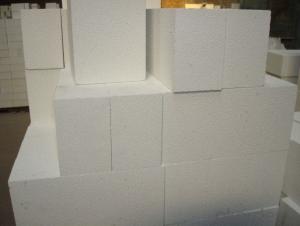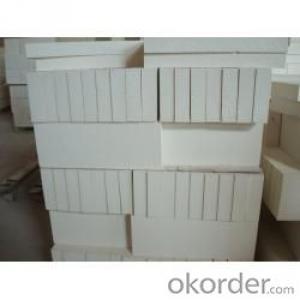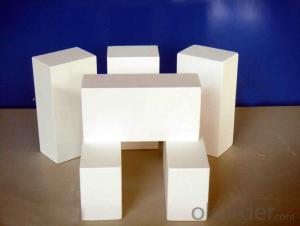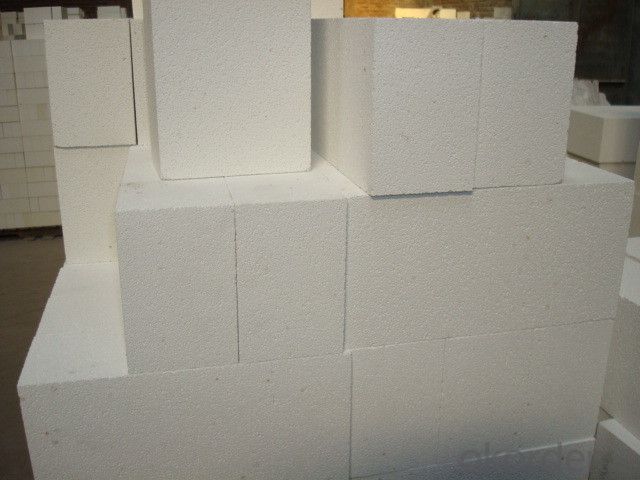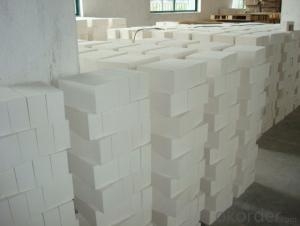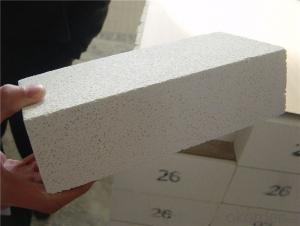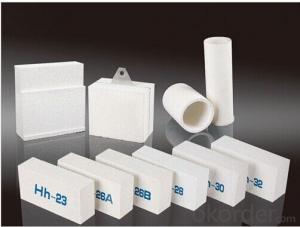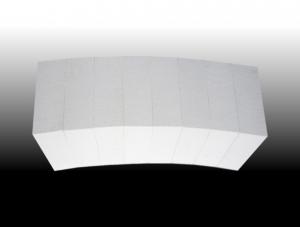Insulating Fire Brick - CCE Fire Light Dense Mullite Insulation Brick
- Loading Port:
- Shanghai
- Payment Terms:
- TT OR LC
- Min Order Qty:
- 1 m.t.
- Supply Capability:
- 10000 m.t./month
OKorder Service Pledge
OKorder Financial Service
You Might Also Like
Thermal Insulation Fire Clay Brick
Refractory brick is a refractory material used in lining furnaces, kilns, fireboxes, and fireplaces.
We provide high quality Refractory Fire Bricks that are used on wide range in the various industries like Cement, Glass and Steel. Refractory Fire Bricks are provided as per the quantity and specifications required by the customers. We provide an extensive range of Refractory Fire Bricks at reasonable prices that depend upon the quantity ordered.
Application
Insulating Fire Brick are used for the lining of converter, alternating current arc furnace, direct Current arc furnace and the ladle slag line, etc.
Company Advantage
(1)Long Insulating Fire Brick manufacture history: 25 years manufacturer
(2)Advanced equipment and good service
(3)Diversification of production standards: ISO ANSI FEPA JIS ASTM
(4)Flexible payment: T/T L/C D/P D/A
(5)Professional marketing team and after-sale service
Insulating Fire Brick main feature:
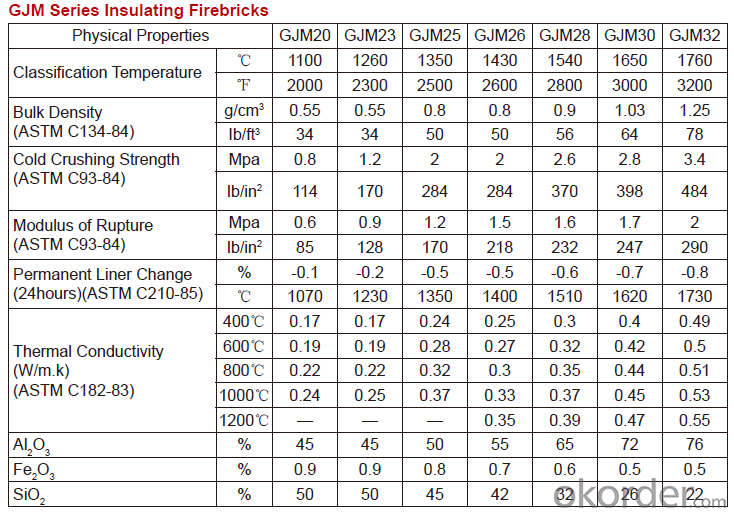
Equipment
1 unit of Ceramic Abrasive (SG Abrasive) pilot production line
2 units of Compact grain Abrasive pilot production lines
1 unit of high-end coated abrasives (abrasive cloth) production line
3 large flexible crushing and sieving lines for grit production lines
6 units of 5000KVA-10000KVA dumping type electric arc furnaces for Brown Fused Alumina fusion
FAQs
Q1 What’s the transport method?
A1 FCL delivery goods with wooden pallet or wooden case by sea; If LCL delivery, must with wooden case; Sometimes need open top, flat rack or bulk cargo.
Q2 What’s the required payment term?
A2 Generally 30% TT as the prepayment, 70% TT before delivery. If need, 100% Irrevocable Letter of Credit or negotiation.
Q3 Which country are our products exported to?
A3 Apart from entire Chinese market, the US, Russia, Japan, Korea, Australia and some Southeast Asian Nations.
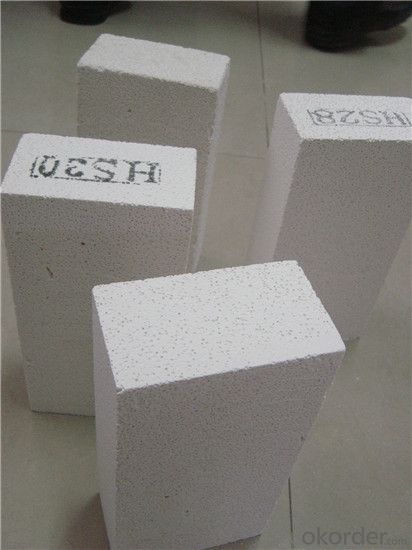

- Q: Can insulating fire bricks be used for insulation in ovens?
- Indeed, ovens can make use of insulating fire bricks for insulation purposes. These bricks are specifically crafted to endure extreme temperatures and offer exceptional insulating capabilities. With their low thermal conductivity, they effectively retain heat, preventing its escape from the oven. This aids in maintaining a steady temperature within the oven, promoting efficient and uniform cooking. Moreover, these bricks are resilient against thermal shock, enabling them to withstand rapid temperature fluctuations without sustaining damage. Consequently, utilizing insulating fire bricks for oven insulation proves to be a sensible and efficient decision.
- Q: Can insulating fire bricks be used in rocket stoves?
- Yes, insulating fire bricks can be used in rocket stoves. Insulating fire bricks are designed to withstand high temperatures and provide excellent insulation, which makes them ideal for use in rocket stoves. They help to retain heat efficiently, ensuring better combustion and increased fuel efficiency in rocket stoves.
- Q: Are insulating fire bricks suitable for use in carbon black furnaces?
- Yes, insulating fire bricks are suitable for use in carbon black furnaces. These bricks are known for their high insulation properties, which help in maintaining high temperatures inside the furnace while preventing heat loss. Additionally, insulating fire bricks are designed to withstand extreme temperatures and chemical reactions, making them a suitable choice for carbon black furnaces that operate under high heat and harsh conditions.
- Q: Are insulating fire bricks suitable for insulation in walls?
- Insulating fire bricks are not typically suitable for insulation in walls. While they are excellent for high-temperature applications, such as lining furnaces or kilns, they have limited insulation properties when it comes to walls. Insulating fire bricks have lower thermal conductivity than regular bricks, meaning they conduct heat at a slower rate. However, they are not as effective as other insulation materials specifically designed for walls, such as fiberglass, foam boards, or mineral wool. These materials are specifically engineered to provide superior insulation properties, such as higher R-values, which measure the material's resistance to heat transfer. Additionally, insulating fire bricks are often more expensive and heavier than other insulation options, making them less practical for wall insulation. Therefore, while insulating fire bricks have their advantages in certain applications, they are generally not the best choice for insulating walls.
- Q: Can insulating fire bricks be used in the construction of refractory linings?
- Indeed, the utilization of insulating fire bricks is possible when constructing refractory linings. These bricks are explicitly engineered to possess exceptional thermal insulation characteristics, rendering them highly suitable for situations necessitating the containment of extreme temperatures. They are frequently employed in the establishment of furnaces, kilns, and other environments that experience elevated heat levels. The insulating attributes of these bricks aid in diminishing heat dissipation, enhancing energy efficiency, and upholding a consistent temperature within the refractory lining. Furthermore, insulating fire bricks are lightweight and effortless to manipulate, thereby constituting a pragmatic selection for the construction of refractory linings.
- Q: Are insulating fire bricks resistant to corrosion?
- Yes, insulating fire bricks are generally resistant to corrosion. Insulating fire bricks are made from high-temperature materials such as alumina, silica, and other refractory materials, which provide excellent resistance to chemical corrosion. These bricks are specifically designed to withstand high temperatures and harsh environments, making them highly resistant to corrosion caused by acids, alkalis, and other corrosive agents. However, it is important to note that the level of corrosion resistance may vary depending on the specific composition and manufacturing process of the insulating fire brick. Therefore, it is advisable to consult the manufacturer or supplier for specific information on the corrosion resistance of a particular insulating fire brick.
- Q: Can insulating fire bricks be used in oil refineries?
- Yes, insulating fire bricks can be used in oil refineries. These bricks are designed to withstand high temperatures and provide excellent insulation, making them suitable for various industrial applications, including oil refineries. They help to reduce heat loss, improve energy efficiency, and protect the surrounding equipment and structures from extreme heat.
- Q: Can insulating fire bricks be used in high-temperature insulation blankets for aerospace applications?
- Insulating fire bricks are typically not used in high-temperature insulation blankets for aerospace applications. This is because insulating fire bricks are solid and rigid, which makes them unsuitable for flexible and conformable insulation applications like insulation blankets. Aerospace applications require insulation materials that can be easily molded and shaped to fit complex geometries, such as the insulation blankets used to protect critical components from extreme heat and temperature fluctuations. Instead, high-temperature insulation blankets for aerospace applications are typically made from flexible and lightweight materials like ceramic fiber or silica fiber. These materials offer excellent thermal insulation properties while also providing flexibility and conformability. They can be easily wrapped around or applied to various components, ensuring effective heat insulation and protection. Furthermore, insulation blankets used in aerospace applications are subjected to stringent requirements such as low outgassing, high thermal stability, and resistance to vibration and mechanical stress. Insulating fire bricks may not meet these specific requirements and may not be able to withstand the extreme conditions experienced in aerospace environments. In summary, while insulating fire bricks are excellent for certain high-temperature insulation applications, they are not suitable for use in aerospace insulation blankets. Aerospace applications require flexible, lightweight, and high-performance insulation materials that can conform to complex shapes and withstand the unique challenges of the aerospace industry.
- Q: How do insulating fire bricks affect the overall efficiency of a heating system?
- The efficiency of a heating system is greatly improved by insulating fire bricks, which have a crucial role to play. These bricks are specifically designed to have low thermal conductivity, allowing them to effectively trap and retain heat within the system. The use of insulating fire bricks significantly reduces heat loss from the system, resulting in improved energy efficiency. One of the main advantages of insulating fire bricks is their ability to minimize heat transfer through conduction. These bricks have a high resistance to heat flow, acting as a barrier that prevents heat from escaping the system. This is particularly important in areas where high temperatures are generated, such as furnaces or kilns. By containing the heat within the system, insulating fire bricks enable the heating system to maintain a consistent temperature, reducing the need for excessive energy consumption to compensate for heat loss. In addition, insulating fire bricks also help decrease heat loss through radiation. These bricks have a high emissivity, meaning they radiate less heat than other materials. As a result, the heat produced by the system is focused on the desired area, rather than being wasted through radiation. This not only improves the efficiency of the heating system but also ensures that the heat is effectively utilized for its intended purpose. Another advantage of insulating fire bricks is their ability to withstand high temperatures without deteriorating. These bricks are composed and manufactured in a way that allows them to handle extreme heat levels, maintaining their structural integrity over time. This durability is crucial for the longevity of the heating system and ensures that the insulating properties of the bricks remain intact. To summarize, insulating fire bricks have a significant positive impact on the overall efficiency of a heating system. Their low thermal conductivity, ability to minimize heat transfer through conduction and radiation, and durability at high temperatures all contribute to reducing heat loss and improving energy efficiency. By incorporating insulating fire bricks into a heating system, users can enjoy a more efficient and cost-effective heating solution.
- Q: Are insulating fire bricks suitable for use in steel manufacturing plants?
- Yes, insulating fire bricks are suitable for use in steel manufacturing plants. Insulating fire bricks have excellent thermal properties, including high heat resistance and low thermal conductivity, which make them ideal for use in high-temperature environments such as steel manufacturing plants. These bricks can withstand the extreme heat generated during steel production processes, such as melting, casting, and forging. Additionally, insulating fire bricks help to conserve energy by reducing heat loss, thus improving the overall efficiency of the plant. They also have good mechanical strength and can withstand the physical stresses and strains associated with steel manufacturing operations. Overall, the use of insulating fire bricks in steel manufacturing plants can help to enhance safety, increase productivity, and improve energy efficiency.
Send your message to us
Insulating Fire Brick - CCE Fire Light Dense Mullite Insulation Brick
- Loading Port:
- Shanghai
- Payment Terms:
- TT OR LC
- Min Order Qty:
- 1 m.t.
- Supply Capability:
- 10000 m.t./month
OKorder Service Pledge
OKorder Financial Service
Similar products
Hot products
Hot Searches
Related keywords
